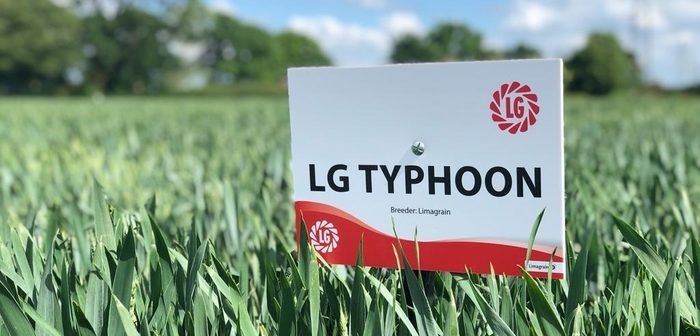LG Typhoon is a high yielding Group 4 hard wheat from breeders Limagrain UK, that joined the AHDB Recommended List in 2022-2023 and will be available to UK growers this autumn.
LG Typhoon offers the package that growers have been asking for in a hard wheat; a high yielding, consistent and resilient variety with a solid all-round disease package and OWBM resistance.
“LG Typhoon delivers an exceptional consistency of performance across very different seasons and regions of the UK, yielding 102% – a great attribute to have in any variety,” says Ron Granger, Limagrain UK’s arable technical manager.
| Rotation | Sowing Date | Soil Type | |||||
| First Cereal | Second Cereal | Early Sep (before 25Sept) |
Trials Sown (25Sept-31Oct) |
Late (after 1Nov) |
Light Soils |
Heavy Soils |
|
| LG Typhoon | 101 | 104 | [105] | 102 | [101] | [102] | 101 |
| Graham | 102 | 101 | 100 | 102 | 100 | 102 | 101 |
Mr Granger acknowledges that whilst yield is important, growers fundamentally like to grow robust varieties that deliver time and again across seasons and rotations. “This is exactly what LG Typhoon does.”
He attributes LG Typhoon’s consistency of performance across locations, seasons and rotations, mostly down to the variety’s excellent all-round foliar disease resistance and agronomic characteristics.
“It has a very good untreated yield (89%); an important attribute even in the hard feed sector, that was traditionally a high input, high output scenario, and is a valuable tool regarding fungicide programmes and timings,” he says.
“LG Typhoon’s resistance rating of 7.2 (3 year data set) for Septoria, comes from a combination of genetic sources different to those in the majority of current RL varieties, and is a significant factor in protecting this resistance rating going forward.”
“It has an excellent yellow rust resistance of 9, combined with YR seedling resistance; a valuable insurance around the earlier spray windows of T0 & T1, where yellow rust can be the main focus in regional high pressure situations.”
However Mr Granger is keen to point out that as both yellow rust and septoria strains are continuosly evolving, all crops should be closely monitored and treated appropriately – a lesson learnt in the 2021 season.
Unlike KWS Dawsum, LG Typhoon offers the very valuable bonus of Orange Wheat Blossom Midge (OWBM) resistance, in addition to a (6) for eyespot and Fusarium.
Mr Granger believes a lot of second wheats could be drilled this autumn, taking into account the high price of wheat, and highlights LG Typhoon’s excellent performance as a second wheat – yielding 104% of control, putting it amongst the most popular varieties in this rotational position.
LG Typhoon also offers very valuable on farm agronomics: “Its stiff straw and good lodging resistance is in line with other feed wheats, such as Gleam.”
“It is a high-tillering variety that performs well at low seed rates, and can be drilled from mid-September to mid-February, however, it exhibits a genuine suitability for the earlier sowing situation, yielding 105% – well over the performance of popular hard wheats Graham and Gleam in this sowing period.”
LG Typhoon is slightly later to mature (+2), similar to Costello, but Mr Granger does not see this as an issue. “As we learnt with our later variety Revelation (+3), it is important to have a range of maturities across the farm to spread harvest risk in catchy seasons,” he adds.
“In terms of grain quality, LG Typhoon has a good specific weight (76.3 kg/hl), similar to that of Gleam
How LG Typhoon fits a Regenerative farming system
There is still much uncertainty about what varieties best suit a ‘regen’ farming system, says Mr Granger.
“However, we know that wheats in a regen system tend to be direct drilled, and in some circumstances early, which means they need to sit back, and not race off too fast in the autumn or early spring, which has implications regarding agronomy inputs and programmes.”
“In our trials last year, where we compared the behaviour of a range of varieties when drilled in this situation, we found that LG Typhoon did just this, sitting prostrate with a slower plant growth through the winter into the spring.”
“The variety is very high tillering and this attribute, combined with the fact that it filled the wider rows with a very high head count, made it the stand out variety in this situation.”
“We also found that LG Typhoon appeared to be more robust in a stress situation, as we saw at the end of April last season when crops had endured a month of frost and drought. Whilst most crops were turning yellow, LG Typhoon stayed greener for longer, which may reflect a superior rooting ability.”
Its excellent disease profile along with OWBM resistance, allows for some flexibility with inputs – which again suits a regen system, he notes.
“Taking all of the characteristics of the variety into consideration, there’s no doubt that LG Typhoon would appear well suited to the regen approach.”
Limagrain will continue to look at the variety in more detail this season, under a range of direct drilled establishment methods and seed rates, to ensure growers have more technical information on the variety, to fulfil this growing area of interest.
LG Typhoon at a glance
- The key word to describe LG Typhoon is ‘resilience’ – it performs consistently well in treated trials across all years of testing and across all regions.
- Its extremely high untreated yield highlights the excellent foliar disease resistances, which include a Septoria resistance package and both adult and seedling resistances to yellow rust.
- It offers flexibility to UK farmers, performing very well as a second wheat, and it is a genuine early drilling variety.
- Characteristics of strong agronomic attributes, growth habit and adaptability of drilling dates, suit a regenerative farming system.




